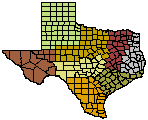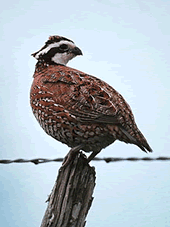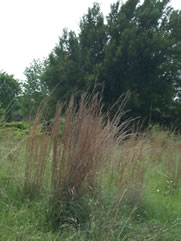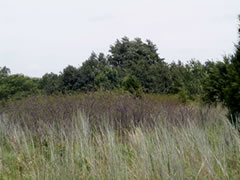- Bobwhite Quail
- Mourning Dove
- Wild Turkey
 Texas Parks and Wildlife Department
Texas Parks and Wildlife Department Wildlife Division District Map
Bobwhite Quail in the Post Oak Savannah and Blackland Prairie
Bobwhite Quail

Historically, bobwhite quail were common throughout the Blackland Prairie and Post Oak Savannah regions of Texas. However, over the last 3 to 4 decades, quail numbers have declined dramatically within these regions and have even disappeared in some localities. The loss of quail is not restricted to these two regions, but is occurring across the state and even throughout the birds' natural range in other states. Statewide, data collected from the U. S. Fish and Wildlife Service's annual Breeding Bird Survey indicate that the bobwhite population has declined at an average rate of 5 % per year from 1980 to 2000. Nationally, the Breeding Bird Survey data indicates that numbers have declined at an average rate of 4 % per year from 1982 to 1999. This decline is staggering, and in some regions of Texas, it is expected that the bobwhite could vanish totally within the next two decades unless changes are made to turn the decline around.

Although there are many factors that have contributed to the bobwhites' decline, the major limiting factor in the Post Oak Savannah and Blackland Prairie regions is the scarcity of quality nesting and brood-rearing cover. Bobwhites will typically build their nests in and around the bases of native bunch grasses such as little bluestem, big bluestem, and Indiangrass. Brood rearing cover is slightly different than nesting cover and is typified by weedy fields that attract numerous insects, provide overhead concealment while feeding, and have bare ground underneath for easy movement. Throughout these two regions, much of this type of habitat has been replaced with exotic warm and cool season pasture grasses (ie. Coastal bermudagrass, annual ryegrass), suppressed by continuous and/or overgrazing of livestock, eliminated by large scale farming practices, or has grown too thick from the lack of disturbance. All of the factors that have reduced or eliminated quality nesting and brood rearing cover are correctable, and with careful planning can be restored. Some practices that could be implemented to restore or improve quail habitat include:
-
Restoring improved pastures, or portions thereof, to native grasses and forbs.
- Cost-share assistance is available through TPWD for restoring native vegetation on improved pastures and hayfields.
- Stock rangeland with livestock at the recommended NRCS stocking rate for the area.
- Rotate livestock through multiple pastures to allow individual pastures time to recover from grazing.
- Thin dense upland woodlands and forest to promote growth of desirable grasses and forbs.
-
Control rank understory vegetation, such as yaupon, in upland woodlands and forests.
- Rank understory vegetation can typically be controlled by with prescribed fire, mechanical clearing, or chemical application.
- Allow fencerows and cropland borders to grow up with brush, native grasses, and forbs.
- Allow some cropland to lay fallow for at least one year to provide good brooding cover.
- Delay mowing or shredding, of pastures and roadsides until at least the end of June to improve successful nesting attempts.
- Plant erodable areas, and field borders on cropland with a mixture of native bunch grasses and forbs.
- Burn, or disk pastures every 2 - 3 years to remove excessive plant litter, improve production from native grasses, and encourage forbs, especially legumes.
 The
loss of adequate low growing woody cover (less than 6 ft. tall), such as plum,
sumac, grape, and greenbriar thickets, has also negatively impacted the bobwhites'
habitat. Low growing cover of this type is very important to the bobwhite
because it protects them from predators and the elements. Cover patches should
be in close proximity to one another, typically about 30-100 feet apart. Additionally,
cover needs to be close to, or adjacent to, a food source such as a weedy
field or cultivated crop. Good low growing cover can be easily provided with
brushy thickets, overgrown fencerows, constructing brush piles, or protecting
patches of prickly pear cactus. When possible, cover should be disbursed throughout
openings and not only along the edges. Cover patches distributed throughout
openings will make the entire area usable for quail rather than being limited
only to the edges.
The
loss of adequate low growing woody cover (less than 6 ft. tall), such as plum,
sumac, grape, and greenbriar thickets, has also negatively impacted the bobwhites'
habitat. Low growing cover of this type is very important to the bobwhite
because it protects them from predators and the elements. Cover patches should
be in close proximity to one another, typically about 30-100 feet apart. Additionally,
cover needs to be close to, or adjacent to, a food source such as a weedy
field or cultivated crop. Good low growing cover can be easily provided with
brushy thickets, overgrown fencerows, constructing brush piles, or protecting
patches of prickly pear cactus. When possible, cover should be disbursed throughout
openings and not only along the edges. Cover patches distributed throughout
openings will make the entire area usable for quail rather than being limited
only to the edges.
Cropland, especially those planted with grain sorghum, corn, or wheat can be very beneficial to bobwhites if managed in a fashion suitable to the birds needs. Bobwhites can thrive in cultivated areas where acreage is relatively small, irregular in shape, and is broken up by idle areas. Idle areas such as fencerows, ditches, and field borders that break up vast cultivated acreage's are very important to making the land suitable to bobwhites. Idle areas must consist of native vegetation, such as perennial bunch grasses, seed producing forbs, and brush. Idle areas planted or seeded with exotic grasses, such as bermudagrass, are of no value to bobwhites. Other practices that will make cultivated land more quail friendly include:
- Leave a few rows on the outer edge of fields un-harvested.
- Avoid treating field borders and the outer few rows with chemicals.
- Reduce field size by leaving 15-30 ft. wide fallow strips throughout.
- Allow a few fields to lay fallow 1-2 years to provide good brooding habitat.
- Establish native grasses, forbs, and brush in erodable areas, field borders and along waterways.
Cost share assistance is available through the USDA's Conservation Reserve Program (CRP) and the Environmental Quality Incentive Program (EQIP) for establishing filter strips, riparian buffers, and grass waterways.
Although the future for bobwhite quail in the Post Oak Savannah and Blackland Prairie regions currently appears bleak, it is not too late make the necessary changes. The key to bringing back the bobwhite lies in the hands of the farmers and ranches of these regions. By understanding the specific habitat needs of the bobwhite, and managing the land to provide for these needs on a year round basis, hopefully we can bring the population of this popular game bird back to where it was 20 years ago.
For assistance in developing a habitat management plan for your property, please contact your local Texas Parks and Wildlife Biologist.
Locate the Texas Parks and Wildlife biologist in your area .
To learn more about the upland game species of the Post Oak Savannah and Blackland Prairie, their habitat and management, click on the appropriate link located on the sidebar.